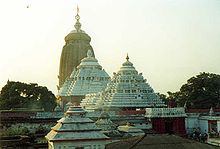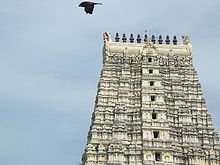- Char Dham
-
For all-denomination Himalayan pilgrimage sites, see Chota Char Dham.Char Dham
Char Dham Badrinath • Rameswaram
Dwarka • PuriChar Dham (Devanagari: चार धाम) (literally: 'the four abodes/seats') are the names of four piligrimage places in India that are widely revered by most of the "Hindus". They are: Badrinath, Dwarka, Jagannath Puri, and Rameshwaram.[citation needed].
The Char Dham defined by Adi Shankaracharya consists of two Vaishnavite, one Shaivite, and one mixed site. Over the years, the term "Char Dham" has lent itself to the all-denomination Char Dham pilgrimages in the Garhwal Himalayas, where Adi Shankaracharya attained freedom from embodiment. Earlier known as Chota Char Dham or 'Little' Char Dham to differentiate them from the bigger circuit of Char Dham sites, after the mid-20th century they themselves started being called the Char Dham[1] Today, the term "Char Dham" usually refers to the all-denomination Himalayan Char Dham. The Char Dham are often considered the most revered sites for Hindus that have to be visited in one's lifetime.
Contents
History
The great 8th century reformer and philosopher Shankaracharya (Adi Sankara) was prominently involved in reviving the Hindu Dharma in India. He travelled throughout the country and grouped the four sacred places Badrinath, Rameshwaram, Puri and Dwarka as the Char Dham which are dedicated to the Vishnu Avatars (incarnations). Geographically speaking the char dham make a perfect square with Badrinath and Rameswaram falling on the same longitude and Dwarka (old) and Puri on the same latitude, representing the farthest north, east, west, and south points of India (at that time, before coastlines changed).
Pilgrimage Centers
Badrinath
Badrinath is located in the North Indian state of Uttarakhand. It is in the Garhwal hills, on the banks of the Alaknanda River. The town lies between the Nar and Narayana mountain ranges and in the shadow of Nilkantha peak (6,560m).
Badri refers to a berry that was said to grow abundantly in the area, and nath means Lord. The legend goes that Shankara discovered a black stone image of Lord Badrinarayan made of Saligram stone in the Alaknanda river. He originally enshrined it in a cave near the Tapt Kund hot springs. In the sixteenth century, the King of Garhwal moved the murti to the present temple.
Dwarka
Dwarka located in the West is in the state of Gujarat, India. The city derives its name from word dvar meaning door or gate in the Sanskrit language. It is located close to where the Gomti River merges into the Gulf of Kutch. The city lies in the westernmost part of India.
The legendary city of Dvaraka was the dwelling place of Lord Krishna. It is believed that due to damage and destruction by the sea, Dvaraka has submerged six times and modern day Dwarka is the 7th such city to be built in the area.
Jagannath Puri
Puri located in the East is located in the state of Orissa, India. Puri is one of the oldest cities in the eastern part of the country. It is situated on the coast of the Bay of Bengal.
The main deity is Shri Krishna, celebrated as Lord Jagannatha. It is the only shrine in India, where goddess, Subhadra, sister of Lord Krishna is worshipped along with her brothers, Lord Jagannatha and Lord Balabhadra. The main temple here is about 1000 years old and constructed by Raja ChodaGanga Deva and Raja Tritiya Ananga Bhima Deva. Puri is the site of the Govardhana Matha, one of the four cardinal institutions or Mathas established by Adi Shankaracharya.
Rameshwaram
Rameswaram located in the South is in the Indian state of Tamil Nadu. It is situated in the Gulf of Mannar at the very tip of the Indian peninsula. According to legends, this is the place from where Lord Rama, built a bridge Ram Setu to Lanka. The Ramanatha Swamy Temple dedicated to Lord Shiva occupies a major area of Rameshwaram. The temple is believed to have been consecrated by Shri Rama.
Rameshwaram is significant for the Hindus as a pilgrimage to Benaras is incomplete without a pilgrimage to Rameswaram. The presiding deity here is in the form of a Linga with the name Sri Ramanatha Swamy, it also is one of the twelve Jyotirlingas.
Further reading
- Char Dham Yatra, by G. R. Venkatraman. Published by Bharatiya Vidya Bhavan, 1988.
- Chardham Yatra, by Savitri Dubey. Published by Alekh Prakashan. ISBN 8188913251.[1]
References
- ^ Char Dham of Garhwal India, by Joe Windless, Sarina Singh, James Bainbridge, Lindsay Brown, Mark Elliott, Stuart Butler. Published by Lonely Planet, 2007. ISBN 1741043085. Page 468.
External links
Categories:- Hindu pilgrimage sites
- Tourism in India
- Char Dham Temples
Wikimedia Foundation. 2010.









